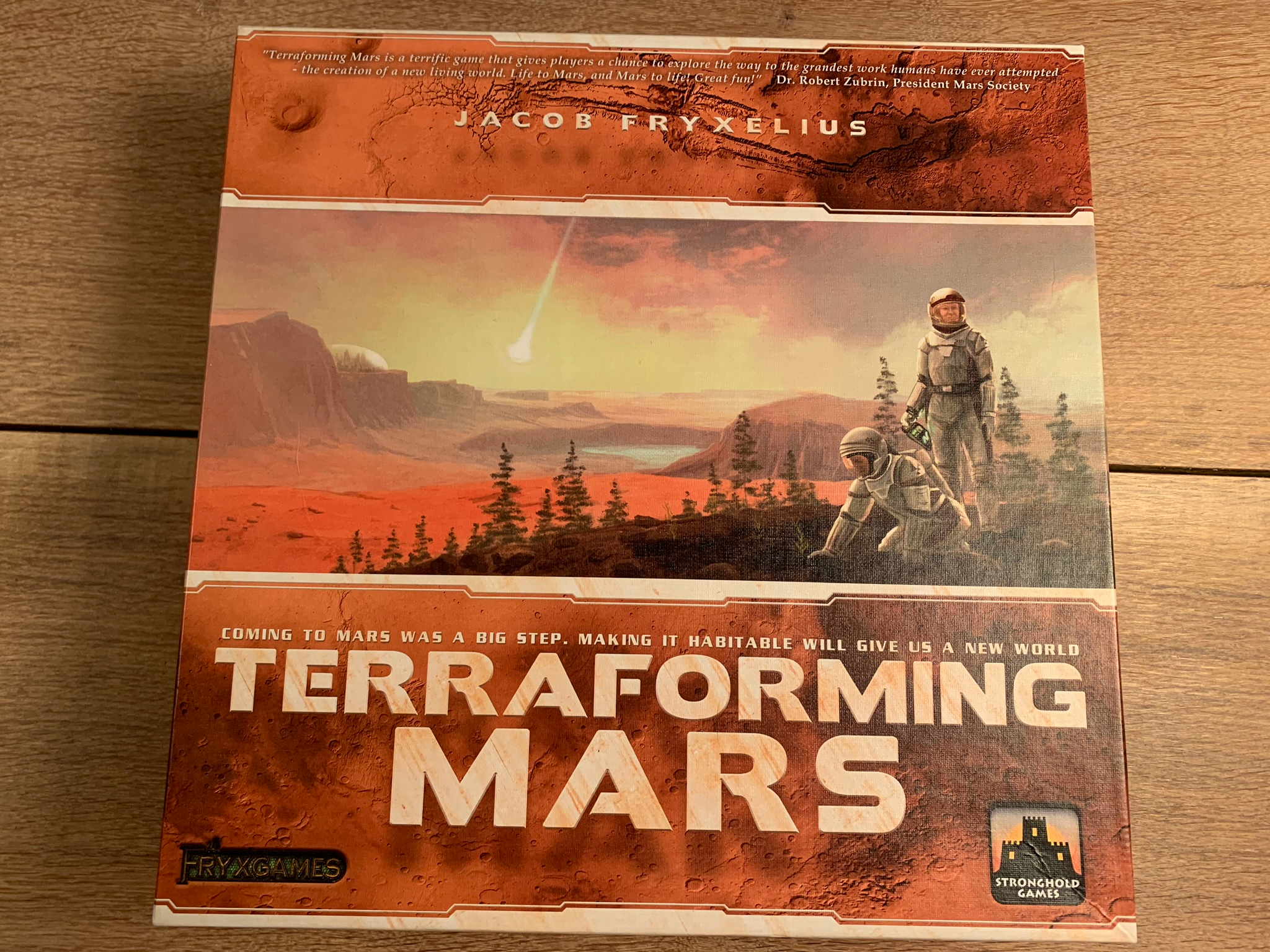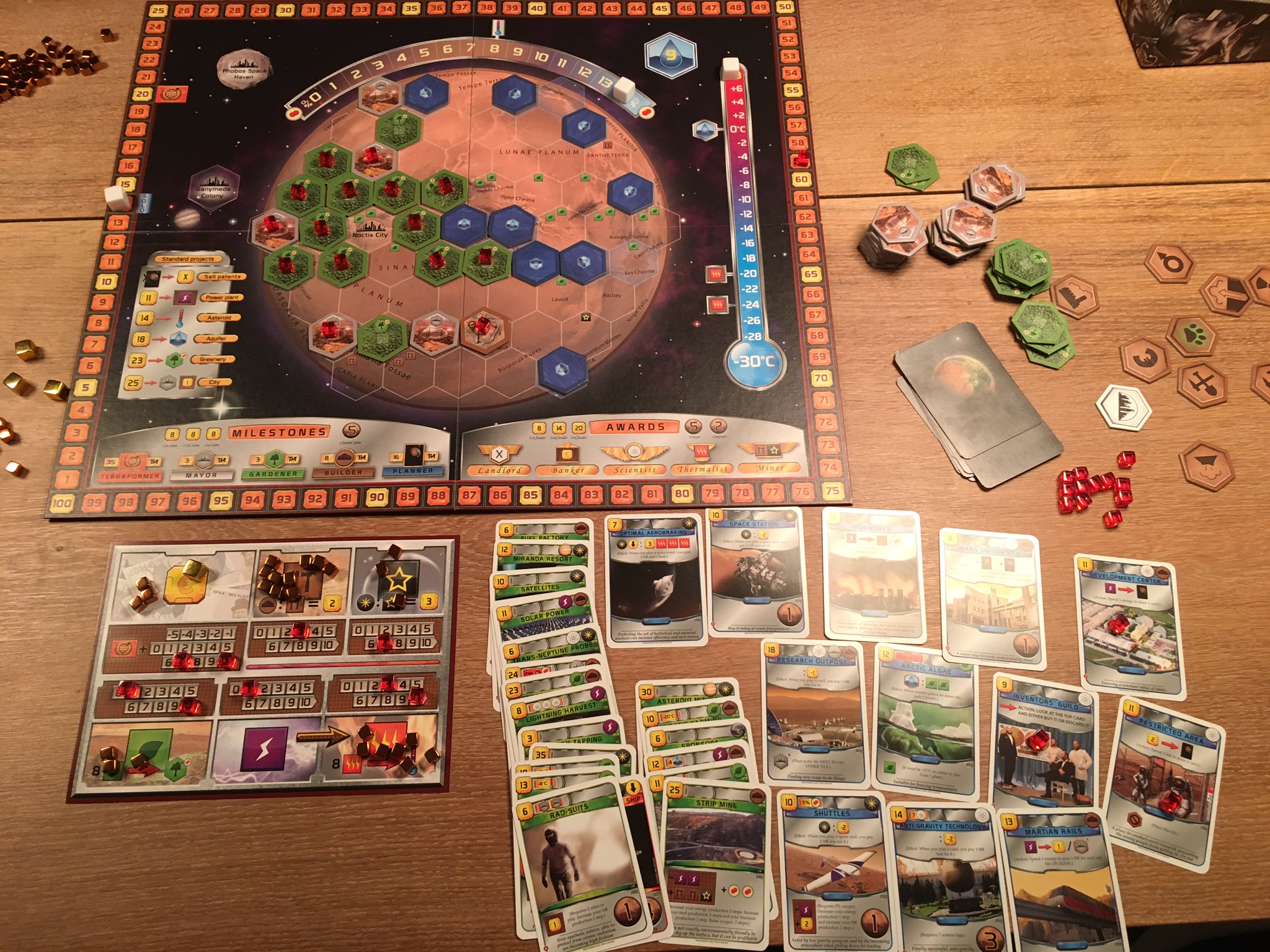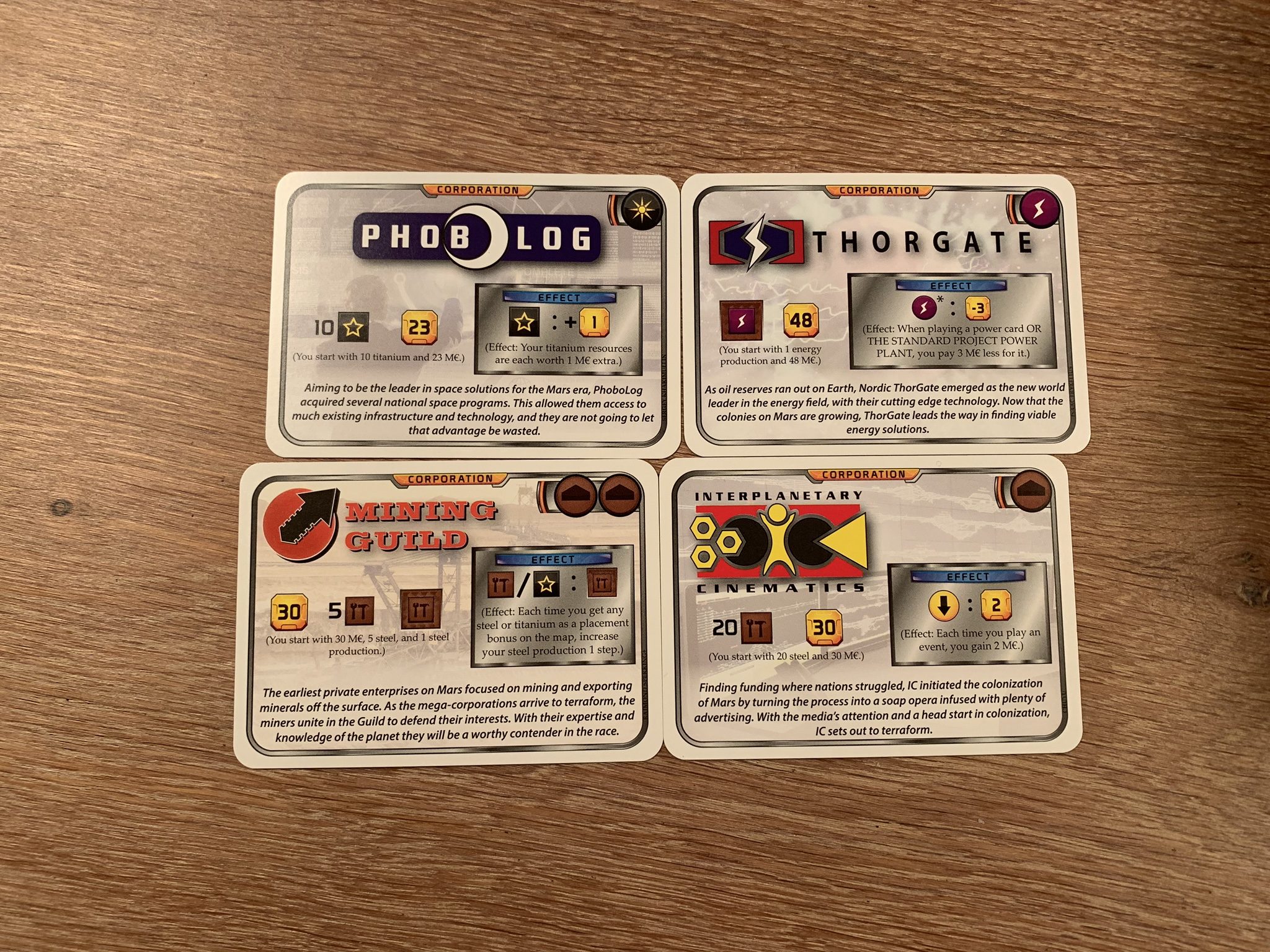
So let’s make Mars great again. It’s not going to be easy, but someone has to do it. It might seem simple “just put some water, make it breathable and warm”. Equipped with a stack of cards, and possible 4 “friends” we can make this happen. I say “friends” as it might seem like you are working together to terraform Mars, but oh there will be backstabbers – backstabbers, who wants to do it all and alone. Although if we want we could do it completely alone and just fight against time (14 rounds).
Game overview
You start with a corporation, which will give you some startup mega credit (which is the currency in the game), some resources and production of these – but it all depends on which corporation. To learn the game it’s recommended to start with the beginner corporation, which gives you a great amount of mega credit and production for each resource.
You get a selection of cards, as a beginner you get these 10 cards free, where you pay for the cards you want to keep. And then it’s off to play the cards in the right order; most cards have some requirements that needs to be met (min or max of water, oxygen or heat) before they can be played. Mega credits runs out quickly, so you have to build a good engine to keep the money flowing and the resources.
In the multiplayer version you are also racing for some awards and special goals to score extra VP (or Terraforming level as it’s called).
The game ends when Mars is completely terraformed (9 water tiles are placed, oxygen and temperature levels are maxed out) and the round it played to the end, with the option of converting your last plants into trees on Mars.
Scoring is based on the amount and placement of tiles (forest and city tiles) and the VP from cards (some can be negative, if you have done something nasty to your fellow travelers) and lastly VP from awards and milestone; and who ever has the most wins.
Game: Terraforming Mars
Player Count: 1-5
Max Playing Time: 120
Year Published: 2016
Rating: 8.36255
Designers: Jacob Fryxelius
Artists: Isaac Fryxelius
Mechanics: Closed Drafting, Contracts, Enclosure, End Game Bonuses, Hand Management, Hexagon Grid
BoardGameGeek
How is it?
 (5 / 5)
(5 / 5)
I have to admit this game did not draw me in from the cover, name and look, I found it looked boring and never looked more into it. Actually the only reason I started playing this game was because of my boyfriend, and not because he is into games, he is actually the opposite. He thought the name had a nice ring to it, and since I didn’t want it, he bought it as a birthday present for me as a “hate” gift and said he would play it with me – so at least I could play with him.
I most say I was wrong about the game and agree with the high rating people give it – lesson learned: don’t judge a board game by it’s cover, component look or name. I really liked it from the beginning, even with the mistakes we made, but also because we never really play games together. I have since then played the game solo and a 5 player play of it. And I will keep playing it.
A huge plus is, this was approved by the boyfriend 🙂
![]()
Strategy & complexity
 (5 / 5)
(5 / 5)
There is quite a bit of strategic decisions to make, in different ways in the multiplayer than in the solo. In multiplayer someone might ruin your strategy, by playing cards that suddenly make your cards not playable; you might also spend your cards to sabotage your opponents instead of thinking about your own progression – sometimes these are also the only cards left.
There is also the racing to get awards and milestone and getting the benefit of raising the different levels required to terraforming Mars and thereby ending the game. So the game can drag out if everyone wants it and the game can end very quickly if all decides.
There is a draft variant, which makes it even more strategic, and more focus on the other players; taking cards just to not give your opponent the option of taking it. You still only pay for the cards you want and not all necessarily all the cards you drafted.
In solo you just play the cards as soon as they are playable, no need to wait – they are only here to help you, and you have to optimize your cards as you only have 14 rounds to do this.
Also the many expansions you can buy (see the Replayability section) to enhance the game and change it.
![]()
Replayability
 (5 / 5)
(5 / 5)
In the base game there is a lot of replayability; there are so many different cards that it will take some time to get used to all cards, and still the randomness freshens it up. There is also the draft variant that can make the game interesting in a different strategic way; which I already mentioned in the “Strategy & complexity” section.
If you get tired of the base game, there are now quite a few expansions to spice it up. As of writing there are currently; which you can mix and match:
Hellas & Elysium
Adds a new double-sided board to freshen things up, with different layout and placement of bonus resources. No new cards added. I have only played this a few times.
Venus Next
Adds a small board with Venus and an extra optional goal of Terraforming Venus and extra awards; also adds a few cards and corporations. I have not played this yet.
Prelude
Speeds up the production of your corporation with some extra benefits, but also shortens the game. For solo play, instead of 14 rounds, you now only have 12 rounds. I have not played this yet.
Colonies
Lets you visit the outer solar system. It comes with colony tiles, on which you can build and send your trade fleet. A few extra cards and corporations are also added. I have not played this yet.
Turmoil
New expansion on Kickstarter, adding different components but also player boards.
![]()
Scalability
 (5 / 5)
(5 / 5)
This games scales very well. I love it as a solo game, loved it as a 2 player and liked it as a 5 player game. The reason I didn’t love it with 5 players was probably because of the players, not really participating and the table we sat at was too big, so it was hard to see what everyone was doing. In this case I think it’s important that you share what you are doing, which they didn’t. I believe 4 player would be better.
The game doesn’t seem to take so much extra time with more players, unless it’s new players. The more players the more time and more AP (Analysis Paralysis) there is. But if all have played this game a few times, and they seem to know what they are doing, I have seen this game play very quick, or at least the turns are quick.
I would play this game at any player count.
![]()
Rules & accessibility
 (5 / 5)
(5 / 5)
The rules are fairly clear, a few misunderstanding on the way, and this might just be due to learning the rules; but it’s easy to find help online. I was a bit confused about the solo setup; which could be interpreted a few ways, but as long as you are consistent in the setup it doesn’t matter.
It’s easy to start playing and the reference cards are really helpful.
![]()
Solo variant
 (5 / 5)
(5 / 5)
The game comes with an official solo variant right out of the box, where you have to do all the hard work of making Mars habitable. It is really crucial that you manage your cards just right, and which corporation and starting cards really makes a difference. I have won only a few times with the special corporation, since you have to do it all within 14 rounds. It is challenging to race against time and no one else helping, at least you don’t have to worry about awards or being the first.
A really nice solo variant with few setup and rule changes compared to the multiplayer version; this makes it easy to tackle playing solo. The game plays fairly quickly as a solo game, but you will still see yourself speculating which is the better option; and sometimes taking back your turn.
![]()
Remote playability
 (3 / 5)
(3 / 5)
I haven’t tested it, but I can’t imagine it being easy; you would need to have more than 1 camera set up to view all the cards played for the different players + the board; and I would recommend not more than 3 players.
![]()
Portability
 (2 / 5)
(2 / 5)
For going with the plane I wouldn’t say it’s very portable. All those cards and tokens weighs quite a bit, let alone the board. What you could do is use D20 or similar for the production values, but you would still need the cubes for playing on the board; but at least they are the light plastic ones.
I wouldn’t recommend packing this for the plane ride, but of course if this is the only game you take and you are travelling lightly it might work.
![]()
Appearance & component quality
 (3 / 5)
(3 / 5)
I’m sorry to say but it does look a bit cheap, when you look at the board, tiles and mega credit cubes: which was also one of the reason I was a bit hesitant to get this game. The mega credit cubes quickly starts to show wear and the tiles are very thin. The player boards are very thin and could have used some indented space for the cubes, which is why you can find many overlays for sale; cubes get pushed off easily. The box has no insert (not even a simple divider) and you are dependent on bags or buying/making an insert to keep everything in order and minimize the setup time.
But the cards on the other hand are very well made, with hidden Easter eggs, good symbols and nice graphics, which fits with the theme. Only setback is the black backside and frame, it will soon get some wear time, and I see why so many sleeve their card. I don’t like sleeves, they produce glare and are slippery and get’s thicker.
All this in consideration, it doesn’t ruin the experience of this excellent game.
Helge’s review
(and Birger)
The box is big enough to sit in, but not a challenge to get in and I do love a challenge. It is possible to get comfy in different lying positions. The box is too thin and won’t withstand many bag leg kicks. There is a lack of components and the variety is low; only cubes. The noise when trying to play with them is okay, but nothing special; bigger and heavier cubes would have raised the level. The cubes are already starting to deteriorate and I fear accidentally eating the residue while playing with them.
On the other paw there are a lot of tiles (although they are a little too thin for my liking) and cards to slide on and interrupt my human’s play, which is always a plus. Even without sleeving the cards; they slide really nicely.
I really like the level of annoyance I can put on my human, and in different ways; blocking the board; sliding on the cards and pushing the cubes.
| Box Fitting: |  (3.5 / 5) (3.5 / 5) |
| Component Noise: |  (3.5 / 5) (3.5 / 5) |
| Component Count & Diversity: |  (3.5 / 5) (3.5 / 5) |
| Component Quality: |  (3.0 / 5) (3.0 / 5) |
| Human Annoyance Level (HAL): |  (5.0 / 5) (5.0 / 5) |
| Average: |  (3.7 / 5) (3.7 / 5) |
Game info
Rules explanation








